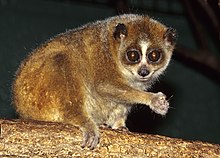Lorisidae(or sometimesLoridae) is a family ofstrepsirrhineprimates.Thelorisidsare all slimarborealanimals and comprise thelorises,pottos,andangwantibos.Lorisids live in tropical, centralAfricaas well as in south and southeastAsia.
| Lorisids[1] Temporal range:
| |
|---|---|

| |
| Pygmy slow loris | |
| Scientific classification | |
| Domain: | Eukaryota |
| Kingdom: | Animalia |
| Phylum: | Chordata |
| Class: | Mammalia |
| Order: | Primates |
| Suborder: | Strepsirrhini |
| Superfamily: | Lorisoidea |
| Family: | Lorisidae Gray,1821 |
| Type genus | |
| Loris Geoffroy,1796
| |
| Genera | |
| Synonyms | |
| |
Classification
editThere are fivegeneraand sixteen species of lorisid.[1]
- OrderPrimates
- SuborderStrepsirrhini:non-tarsier prosimians
- InfraorderLemuriformes
- SuperfamilyLemuroidea
- SuperfamilyLorisoidea
- Family Lorisidae
- SubfamilyPerodicticinae
- GenusArctocebus,angwantibos
- GenusPerodicticus,pottos
- SubfamilyLorisinae
- GenusLoris,slender lorises
- GenusNycticebus,slow lorises
- GenusXanthonycticebus,pygmy slow loris[3]
- SubfamilyPerodicticinae
- FamilyGalagidae:galagos
- Family Lorisidae
- InfraorderLemuriformes
- SuborderHaplorrhini:tarsiers, monkeys and apes
- SuborderStrepsirrhini:non-tarsier prosimians
Description
editLorisids have a close, woolly fur, which is usually grey or brown, darker on the top side. The eyes are large and face forward. The ears are small and often partially hidden in the fur. The thumbs are opposable and the index finger is short. The second toe of the hind legs has a fine claw for grooming, typical for strepsirrhines. Their tails are short or are missing completely. They grow to a length of 17 to 40 cm and a weight of between 0.3 and 2 kg, depending on the species. Theirdental formulais similar to that oflemurs:2.1.3.32.1.3.3
Behavior and ecology
editLorisids arenocturnalandarboreal.Unlike the closely relatedgalagos,lorisids never jump. Some have slow deliberate movements, whilst others can move with some speed across branches. It was previously thought that all lorisids moved slowly, but investigations using red light proved this to be wrong. Nonetheless, even the faster species freeze or move slowly if they hear or see any potential predator. This habit of remaining motionless whilst in danger is successful only because of the leafy environment of their jungle home, which helps to conceal their true position.[4]With their strong hands they clasp at the branches and cannot be removed without significant force. Most lorisids are solitary or live in small family groups.
Slow lorisesfrom southeast Asia produce asecretionfrom their brachial gland (ascent glandon the upper arm, between theaxillaand elbow), that is licked and mixed with their saliva to form a toxin which may be used for defense. Thered slender loris(Loris tardigradus) from India also possesses brachial glands, but it is uncertain whether they also synthesize the toxin. Thepotto(Perodicticus potto) is thought to lack brachial glands, though it produces similar toxic excretions with its anal glands.[5]
Lorisids have agestationperiod of four to six months and give birth to two young. These often clasp themselves to the belly of the mother or wait in nests, while the mother goes to search for food. After three to nine months - depending on the species - they areweanedand are fully mature within 10 to 18 months. Thelife expectancyof lorises can be to up to 20 years.
Lorisids consumeinsects,bird eggsand smallvertebratesas well asfruitsandgums.[6][7][8][9]
References
edit- ^abGroves, C. P.(2005).Wilson, D. E.;Reeder, D. M. (eds.).Mammal Species of the World: A Taxonomic and Geographic Reference(3rd ed.). Baltimore: Johns Hopkins University Press. pp. 121–123.ISBN0-801-88221-4.OCLC62265494.
- ^Brandon-Jones, D.; Eudey, A. A.; Geissmann, T.; Groves, C. P.; Melnick, D. J.; Morales, J. C.; Shekelle, M.; Stewart, C.-B. (2004)."Asian Primate Classification"(PDF).International Journal of Primatology.25(1): 100.doi:10.1023/b:ijop.0000014647.18720.32.S2CID29045930.
- ^Nekaris, K. Anne-Isola; Nijman, Vincent (2022-03-23)."A new genus name for pygmy lorises, Xanthonycticebus gen. nov. (Mammalia, primates)".Zoosystematics and Evolution.98(1): 87–92.doi:10.3897/zse.98.81942.ISSN1860-0743.S2CID247649999.
- ^Charles-Dominique, Pierre (1984). Macdonald, D. (ed.).The Encyclopedia of Mammals.New York: Facts on File. pp.332–337.ISBN0-87196-871-1.
- ^Alterman 1995,pp. 421–423.
- ^Estes, R. D.(1991).The Behavior Guide to African Mammals.University of California Press. pp.458.ISBN978-0520080850.
- ^Svensson, M.; Nekaris, K.A.I. (2019)."Arctocebus aureus".IUCN Red List of Threatened Species.2019:e.T2053A17969875.Retrieved24 December2019.
- ^"Slender loris - Introspective World".anintrospectiveworld.blogspot.ca.14 May 2013.Retrieved5 April2018.
- ^Streicher, U.; Singh, M.; Timmins, R.J. & Brockelman, W. (2008)."Nycticebus bengalensis".IUCN Red List of Threatened Species.2008:e.T39758A10263081.doi:10.2305/IUCN.UK.2008.RLTS.T39758A10263081.en.Retrieved24 December2019.
Literature cited
edit- Alterman, L. (1995). "Toxins and toothcombs: potential allospecific chemical defenses inNycticebusandPerodicticus".In Alterman, L.; Doyle, G.A.; Izard, M.K (eds.).Creatures of the Dark: The Nocturnal Prosimians.New York, New York: Plenum Press. pp. 413–424.ISBN978-0-306-45183-6.OCLC33441731.